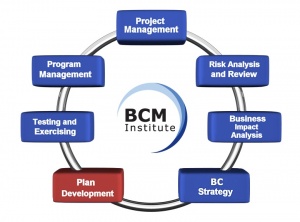Incident Command Systems (ICS)
| 1. The Incident Command System or ICS is a management system for conducting on-site operations.
Notes (1): The Incident Command Systems (ICS) has a standardized operation structure and common terminology; it provides a useful and flexible management system that is particularly adaptable to incidents involving multi-jurisdictional or multi-disciplinary responses. It is also applicable to small scale daily operational activities as well as major mobilizations.
 Implementing Your Business Continuity Plan BUY!
| ||||||||||||||||||||||||||||
Courses
- Attend: Plan Development Business Continuity Courses
- Attend: Competency-based Plan Development Business Continuity Courses
- Attend: E-Learning: Plan Development Business Continuity Courses
Guidance Notes and Templates
- Guidance Notes to Complete the Plan Development Template
- Guidance Notes to Complete the Pandemic Flu BC Plan Development Template
|
(Source: Business Continuity Management Institute - BCM Institute) |
2. The combination of facilities, equipment, personnel, procedures and communications operating within a common organizational structure, designed to aid in the management of resources during incidents.
(Source: NFPA 1600 Standard on Disaster/Emergency Management and Business Continuity Programs, NFPA 1600:2007)
3. Combination of facilities,equipment, personnel, procedures and communications operating within a common organizational structure with responsibility for management of assigned resources to effectively direct and control the response to an incident. Intended to expand,as situation requires a larger resources, without requiring new, reorganized command structure.
(Source: Australia. A Practitioner's Guide to Business Continuity Management HB292 - 2006 )
4. Combination of facilities, equipment, personnel, procedures, and communications operating within a common organisational structure with responsibility for the command, control, and coordination of assigned resources to effectively direct and control the response and recovery to an incident.
(Source: ENISA - the European Network and Information Security Agency. BCM & Resilience Glossary)

